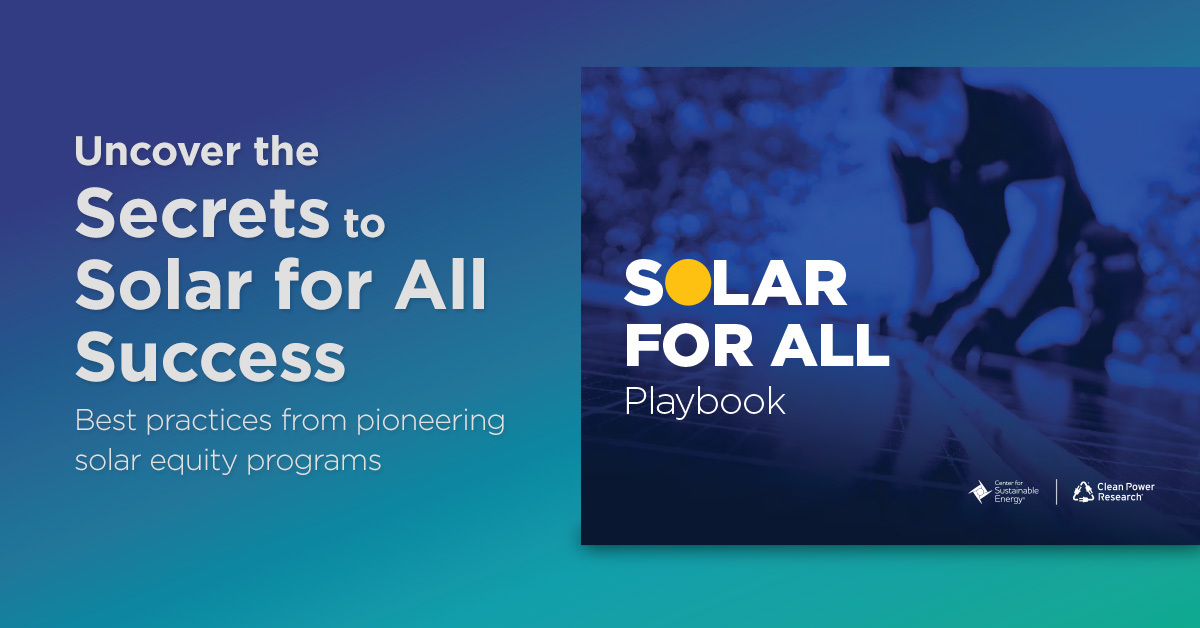How to Ensure Your Solar for All Program Stays on Track and Succeeds

Across the nation over the next year, 60 major equity-focused solar energy programs will be launched or enhanced by cities, states, tribal nations, and nonprofits.
Putting $7 billion in federal Solar for All funding to work as fast as possible – and keeping programs on track over five years – will require smart planning and data-driven decision-making.
Center for Sustainable Energy (CSE) offers some best practices to help awardees refine and design their programs and spread the benefits of solar to some 900,000 households in low-income and disadvantaged communities.
Start with intentional program design
Intentional program design is a process in which end-users are considered from start to finish. It focuses on local needs and integrating program design that meets goals relevant to recipients.
Intentional program design relies on three key pillars: Plan for program data requirements, build in ways to support projects toward completion and understand the target audience journey.
1. Plan for program data requirements
Solar for All has numerous data and reporting requirements, such as demonstrating a minimum of 20% household utility bill savings to all households served under the program overall. To meet the requirements, it’s important to set metrics and plan for data collection upfront and build in data tracking during the program design phase.
For example, California’s $1 billion Solar on Multifamily Affordable Housing (SOMAH) Program requires at least 51% of the installed system be allocated to benefit tenants. This requirement directly relates to the utility interconnection process, which is separate from the incentive application. Through intentional design, the SOMAH application has safeguards to ensure the minimum allocation threshold is met.
The administrative review process allows the SOMAH Program administration team to:
- Verify the continuity of documentation.
- Capture necessary data points.
- Obtain final utility signoff through permission-based access to the application platform.
The SOMAH administration team, which is composed entirely of nonprofits, including CSE, uses Clean Power Research’s PowerClerk® as its application platform. Using PowerClerk, which is easily configurable, the SOMAH team can also track data at a granular level and log all changes to meet data requirements. Streamlining and automating data collection increases program administration efficiency, saving time and money.
2. Build in ways to speed projects toward completion
As Solar for All funds become available, it will be important to rapidly deploy them to qualified applicants and start seeing results in the community.
One approach to consider is a tiered application structure that prioritizes projects furthest along in their development cycle. This will help ensure that funds are not obligated for projects that may not be ready or even feasible.
Another useful tool is a construction progress tracker that can identify any project that may be falling behind and provide insights into any recurring barriers in the process in general. Automating deadline reminders and updates allows the program administrator to maintain awareness of the program pipeline and reduce administrative costs.
For example, to address the need for faster deployment of high-speed EV chargers, the California Electric Vehicle Charging Incentive Project (CALeVIP) in 2023 replaced its first-come, first-served application process with a tiered process based on construction readiness, with requirements clearly communicated. A new construction tracker allows applicants to easily see next steps while also allowing CSE, as the program administrator, to identify barriers to installation that need to be addressed. This approach manages an overall project pipeline effectively to minimize costly administration and delays.
3. Understand the target audience journey
Designing a program approach starts with an outline of the user experience through a consumer lens. From there, break down the steps and actions of the journey, and use deep knowledge from previous programs and seasoned administrative staff and advisors to streamline the customer experience. It’s important to thoroughly consider what the program is trying to accomplish, the workflow and overall metrics, then incorporate communications and technologies that streamline the applicant’s experience.
Taking a big-picture approach to the full life cycle of both individual projects and the overall program when designing and deploying programs ensures no one is left behind and creates the most efficient experience for program staff, sponsors, stakeholders and consumers.
How CSE can help
The EPA will complete reviews of Solar for All grant recipients’ programs this summer. Then in fall and winter, it’s anticipated they will deploy funds to existing programs first, and to new programs soon after.
As awardees focus on final plans and decisions to ensure well-conceived, well-executed programs, CSE and Clean Power Research are offering guidance based on nearly 50 years of combined experience designing, administering and creating programs and software for large-scale solar and energy storage programs nationwide. Learn more in our Solar for All Playbook.
Government employees can get a copy of our Solar for All Playbook for more tips on launching a successful solar equity program.
Download the playbook here.


